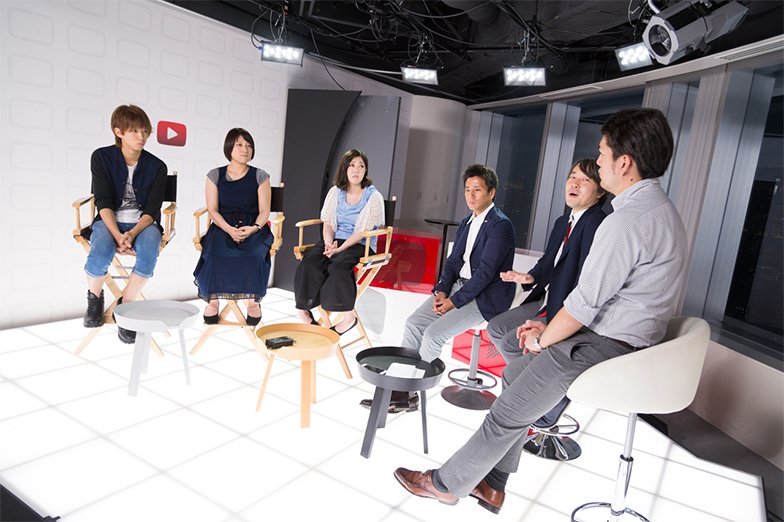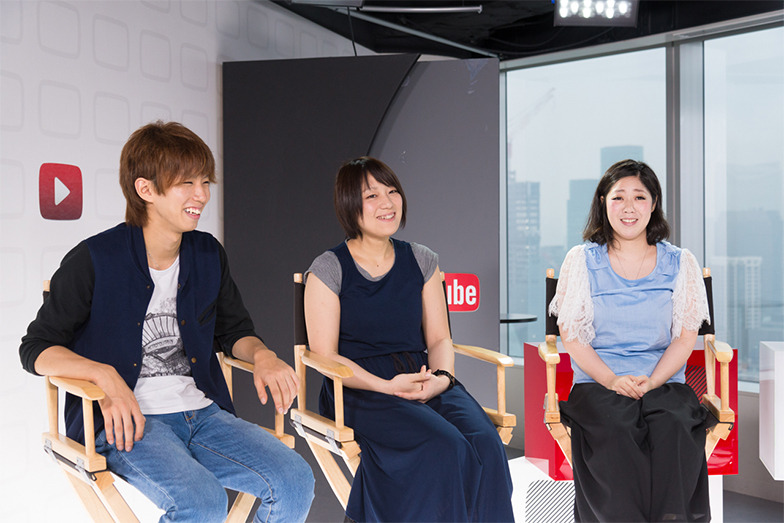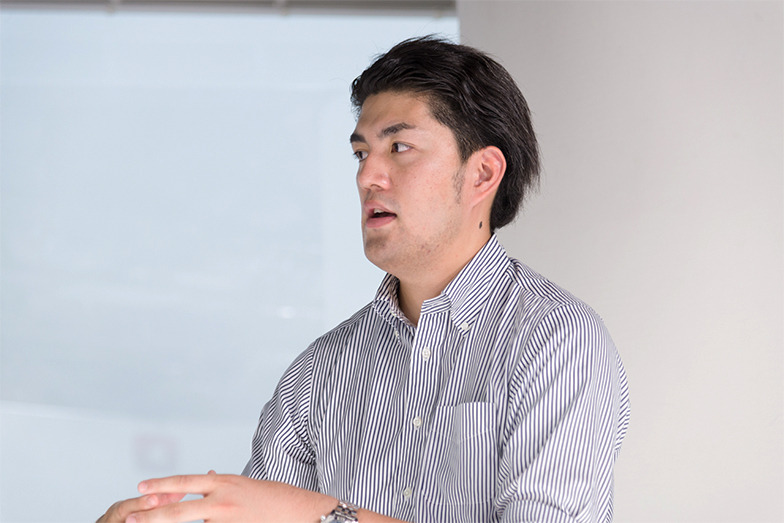On a certain day in July, a discussion was held at YouTube Space Tokyo in the city, featuring people engaged with YouTube from various perspectives.
Up to this point, the discussion has covered key points in creating online video content, as practiced by popular YouTuber Hajime Shacho and the Japan Elektel Union, and how to effectively utilize YouTube as a media platform for marketing activities.
This concluding session of the discussion will explore the future of marketing communication, insights emerging from our reflections on YouTube.
YouTubers Who Create That "I Just Love This" Feeling
Ikegami:Last time, Nippon Elektel Union pointed out that by consciously making viewers feel "this isn't for everyone, it's for you," it taps into the subconscious of fans. It was also interesting how Haji-shacho's cola bath was funny precisely because he did it – the relatability comes from the YouTuber, not the company.
I think this trend is influenced by how viewing environments have shifted to more personal devices like PCs and smartphones in recent years. Hasegawa, do you also notice this sense of "familiarity" in your daily experience?
Hasegawa: Honestly , when I watch YouTube, I often find myself noticing and wanting the things YouTubers use. It makes sense when you think about it: watching different videos by the same YouTuber daily builds familiarity. For example, after watching Hajime Shacho's videos, I might suddenly crave cola, or after watching Nippon Elektel Union's videos, I might want a cap and stadium jacket like "Semi-chan's." That's precisely the kind of connection only YouTubers can create.
Nihon Elektel Rengō (hereafter Elektel): We once featured a panda plushie that was leftover at our agency in a video. We hadn't planned to sell it, but we got flooded with inquiries from viewers. It ended up generating unexpected sales, and our agency even said we could use that money to buy YouTube equipment. Later, it showed up on Yahoo Auctions and started fetching a premium... (laughs).
Ikegami: This is also likely due to the relatability YouTubers create, right?
Higashihata: Just like YouTube's tagline, "Make a living doing what you love" is appealing to both YouTubers and viewers. I feel you can't apply traditional marketing perspectives here. It's not about ads saying "Buy this because you need it," but rather the context of "I kinda like this" that resonates better with YouTubers.
A New Form of Media Mix
Ikegami: When you consider YouTube as your home base for building that connection with viewers, how do other platforms like TV and stage performances fit into your overall strategy?
Elektel: TV and stage are definitely important too. Thanks to TV, we've reached many people, and as a result, they've also discovered our YouTube channel, which has been our main platform for a long time. So YouTube, TV, and stage are all crucial. Within that, YouTube is where we can do what we love, TV is where we get to challenge ourselves with new projects through various concepts, and stage is where we can face the audience live.
Hasegawa: As YouTube creators, we don't think "just focus on YouTube." We want them to thrive everywhere—on TV, at real events, on other social media. Speaking of real events, take Haji-shacho's case: tens of thousands apply for his handshake events.
Similarly, at Elekiter's events, we see incredibly strong engagement from fans who are so deeply invested in the characters that they cry when seeing them live. This happens because they've built relationships that go beyond just enjoying the content. In that sense, I feel it's crucial for creators to be active outside of YouTube too.
Elektel: Our ideal is for YouTube, TV, and stage performances to all function well together. We used to have live shows that didn't sell out, but after appearing on TV and YouTube, they started filling up. Appearing on TV boosted our YouTube channel, and because we were active on YouTube, we were recently invited to an event. We haven't achieved a perfect triangle yet, but we hope YouTube, TV, and events can all create a synergistic effect.
Ikegami: It's a new form of media mix with YouTube as the core, isn't it?
Hasegawa: It's not just real events. The game app we provide for iPhone, created by Hajime Shacho, actually ranks higher than apps heavily advertised on TV. This is also a result of the synergy flowing back and forth across YouTube, real events, TV, Twitter, and various other platforms.
Hajime Shacho (hereafter Hajime): It's just a tap-based game though... (laughs).
Future marketers must shift from "target-oriented" to "fan-oriented"
Higashihata: It really drove home how something incredible is happening on YouTube. Hajime Shacho achieved this massive breakthrough in just two years, and even Elekiter needed to post videos as their calling card just three years ago.
The shift in the media landscape, driven by online video gaining mainstream acceptance, is something we in corporate marketing must humbly acknowledge. The fundamental approach to creating TV commercials, films, and videos like those on YouTube is fundamentally different, and marketers need to seriously consider this. The era of personal media has truly arrived; it's an age where individuals are becoming the media.
Ikegami: YouTube offers equal opportunity to everyone—individuals and companies alike—generating massive traffic. While focusing on the platform itself and creators like your two groups is important, staying close to the fanbases formed there will be essential for future marketing.
Higashihata: Precisely—it's not about targets, but fans. Marketing often defines consumers as "targets," but YouTubers are building "fans." This is a major shift. I believe corporate marketing should evolve beyond targeting specific audiences and instead focus on "growing fans."
Hasegawa: To gain insights into building fans in marketing, I think it's crucial to first carefully observe what YouTubers and successful companies in other countries are doing on YouTube.
Elektel: YouTube is accessible to anyone. Whether you're someone like us affiliated with an agency or a student like Hajime Shacho, everyone starts on the same footing—it's completely equal. We find joy in being able to steadily upload videos every day in that environment.
Hajime: I agree completely. My YouTube channel is finally gaining attention and reaching a large audience. Initially, I focused on wanting to be popular and stand out. But now, watching various videos beyond YouTube, my perspective has broadened—I want to improve quality, try creating different things. I aim to enhance quality while learning specialized skills like camera work and editing.
Hasegawa: While working with these two groups this time, I repeatedly heard praise from Dentsu Inc. creators like, "Japan Elektel Union is addictive," and "Hajime Shacho is amazing." Regarding the Union, they were amazed by their perseverance in releasing sketches daily and their acting and expressive skills in fully embodying their characters. For Hajime, they highly praised the unexpected nature of his video ideas – things professionals wouldn't think of, like racing against a tape measure as it rewinds. I want to share this sense of wonder more with people in the advertising industry.
Ikegami: The expansion of YouTube as a platform for YouTubers is also a result of creators like Elekiter and Hajime building a fanbase by fostering a sense of "relatability." And that is essentially "fan creation" – marketing itself.
As Hasegawa-san mentioned, it's important to watch YouTube not just as a viewer, but also from a marketing perspective, asking "Why do this person or this video have so many fans?"
It's precisely because everyone involved communicates frequently on this equal platform that each channel and YouTuber has a solid fanbase tied to them. There's much we can learn from this fact.












